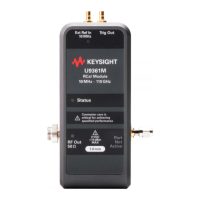U9361C/F/G/M RCal Measurement Guide 19
Getting Started
RCal Software – Calibration and Application
In most applications, the state parameters of a given measurement can be
found and set via:
— The Meas Bar summary (at top of screen)
— The Meas Setup menu
Best RCal Configuration Practices
The following recommendations should be considered when creating RCal
calibration states:
— Plan for how the signal analyzer will be used after calibration, so that the
corrections are valid for later changes in measurement parameters.
— Start with a a simple configuration and gradually configure for higher
complexity. For example, start with a single row, a small number of
frequency steps, and a small range of attenuation steps before further
increasing these values as needed.
— In general, leave Match State set to False. See “How to Utilize Match
State” on page 19 for more information.
— If you use the Duplicate Row feature, verify that the original row works
correctly, and does not take an excessively long time before copying to
another row.
Multiple SA Input Ports and RCal Modules
Most signal analyzer systems employ a single input port. However, some
analyzers (such as the N9041B) have more than one input. If you need to
calibrate both inputs, create a Cal Group for each RF input port, since each Cal
group may choose which module is associated with that group.
How to Utilize Match State
Acquisitions rarely match the exact hardware state at which the original RCal
correction was performed. The stored correction must be converted to the
correction required for the exact hardware acquisition state. This conversion is
controlled by the Match State parameter within the RCal configuration
window.
If you want to only apply corrections to test setups that exactly match the state
of their RCal calibration(s), you should set the Match State to True. If you want
to apply RCal corrections to similar hardware states that may not exactly
match the original hardware calibration state, you should set the Match State
to False. When the Match State is set to False, the following rules are
followed:
— Situations that are close enough will use the closest available correction.
— Situations that are too different will never be selected even when the Match
State is set to False.

